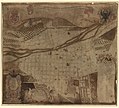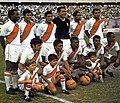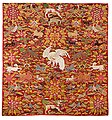Portal:Peru
Introduction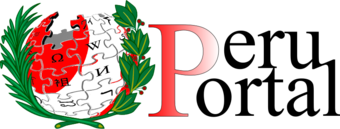
Peru, officially the Republic of Peru, is a country in western South America. It is bordered in the north by Ecuador and Colombia, in the east by Brazil, in the southeast by Bolivia, in the south by Chile, and in the south and west by the Pacific Ocean. Peru is a megadiverse country with habitats ranging from the arid plains of the Pacific coastal region in the west to the peaks of the Andes mountains extending from the north to the southeast of the country to the tropical Amazon basin rainforest in the east with the Amazon River. Peru has a population of over 32 million, and its capital and largest city is Lima. At 1,285,216 km2 (496,225 sq mi), Peru is the 19th largest country in the world, and the third largest in South America. Peruvian territory was home to several cultures during the ancient and medieval periods, and has one of the longest histories of civilization of any country, tracing its heritage back to the 10th millennium BCE. Notable pre-colonial cultures and civilizations include the Caral–Supe civilization (the earliest civilization in the Americas and considered one of the cradles of civilization), the Nazca culture, the Wari and Tiwanaku empires, the Kingdom of Cusco, and the Inca Empire, the largest known state in the pre-Columbian Americas. The Spanish Empire conquered the region in the 16th century and Charles V established a viceroyalty with the official name of the Kingdom of Peru that encompassed most of its South American territories, with its capital in Lima. Higher education started in the Americas with the official establishment of the National University of San Marcos in Lima in 1551. Peru's population includes Mestizos, Amerindians, Europeans, Africans and Asians. The main spoken language is Spanish, although a significant number of Peruvians speak Quechuan languages, Aymara, or other Indigenous languages. This mixture of cultural traditions has resulted in a wide diversity of expressions in fields such as art, cuisine, literature, and music. (Full article...) Entries here consist of Good and Featured articles, which meet a core set of high editorial standards.
The Carancas impact event refers to the fall of the Carancas chondritic meteorite on September 15, 2007, near the village of Carancas in Peru, close to the Bolivian border and Lake Titicaca. The impact created a small crater in the clay soil and scorched earth around its location. A local official, Marco Limache, said that "boiling water started coming out of the crater, and particles of rock and cinders were found nearby", as "fetid, noxious" gases spewed from the crater. Surface impact occurred above 3,800 metres (12,500 ft). After the impact, villagers who had approached the impact site grew sick from a then-unexplained illness, with a wide array of symptoms. Two days later, Peruvian scientists confirmed that there had indeed been a meteorite strike, quieting widespread speculation that it might have been a geophysical rather than a celestial event. At that point, no further information on the cause of the mystery illness was known. The ground water in the local area is known to contain arsenic compounds, and the illness is now believed to have been caused by arsenic poisoning incurred when residents of the area inhaled the vapor of the boiling arsenic-contaminated water. (Full article...)Selected image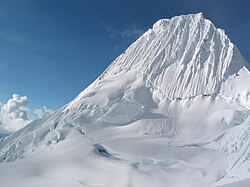 Photo credit: RedWolf
Alpamayo (Spanish: Nevado Alpamayo) is one of the most conspicuous peaks in the Cordillera Blanca mountain range of the Peruvian Andes. It is a steep (sixty degrees), almost perfect pyramid of ice, one of a number of peaks that compose the Santa Cruz massif, the northernmost massif of the Cordillera Blanca. Although smaller than many of its neighboring peaks, it is distinguished by its unusual formation and overwhelming beauty. It actually has two sharp summits, North and South, separated by a narrow corniced ridge. (more...) Selected battleThe Battle of (or Massacre at) Cajamarca (November 16, 1532) was a surprise attack on the Inca royal entourage orchestrated by Francisco Pizarro. Sprung in the evening in the great plaza of Cajamarca, the ambush claimed the lives of thousands of Incas and achieved the goal of capturing Emperor Atahualpa. The confrontation at Cajamarca was the culmination of a months-long struggle involving espionage, subterfuge, and diplomacy between Pizarro and the Inca via their respective envoys. Atahualpa had received the invaders from a position of immense strength. Encamped along the heights of Cajamarca with legions of battle-tested troops fresh from their victories in the civil war against his half-brother Huáscar, the Inca felt they had little to fear from Pizarro's tiny army, however exotic its dress and weaponry. In a calculated show of goodwill, Atahualpa had lured the adventurers deep into the heart of his mountain empire where any potential threat could be met with a show of force. (more...) In this month
General imagesThe following are images from various Peru-related articles on Wikipedia.
Selected article -The Ecuadorian–Peruvian territorial dispute was a territorial dispute between Ecuador and Peru, which, until 1928, also included Colombia. The dispute had its origins on each country's interpretation of what Real Cedulas Spain used to precisely define its colonial territories in the Americas. After independence, all of Spain's colonial territories signed and agreed to proclaim their limits in the basis of the principle of uti possidetis juris, which regarded the Spanish borders of 1810 as the borders of the new republics. However, conflicting claims and disagreements between the newly formed countries eventually escalated to the point of armed conflicts on several occasions. The dispute de jure had come to an end in the aftermath of the Ecuadorian–Peruvian War with the signing of the Rio de Janeiro Protocol on January 29, 1942. However, this treaty was also questioned, and the two countries went to war on two more occasions: the Paquisha War in 1981, and the Cenepa War in 1995. Tensions subsided but persisted over the next three years. On October 26, 1998, Ecuador and Peru signed a comprehensive peace accord that established a framework for ending a border dispute. Formal demarcation of border regions started on May 13, 1999. The agreement was ratified without opposition by the congresses of both nations, finally bringing a definitive end to the dispute. (Full article...)Did you know (auto-generated) -
CategoriesRelated portalsSelected quote -
English Nonconformist Isaac Watts 1674–1748
Basic facts & figuresMore did you know...
Peru TopicsRecognized content
Featured articlesFeatured listsGood articles
WikiProjectsThings you can do
New articlesThis list was generated from these rules. Questions and feedback are always welcome! The search is being run daily with the most recent ~14 days of results. Note: Some articles may not be relevant to this project.
Rules | Match log | Results page (for watching) | Last updated: 2024-05-09 21:56 (UTC) Note: The list display can now be customized by each user. See List display personalization for details.
Associated WikimediaThe following Wikimedia Foundation sister projects provide more on this subject:
Discover Wikipedia using portals | |||||||||||||||







